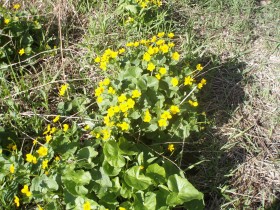SIGNS OF SPRING: Cowslips and Warblers!!!
Happy Mother’s Day. motherhood has been a popular topic with the young visitors to Crossroads. With frog choruses each evening and birds engaging in courtship behavior, the concept of motherhood is unavoidable this time of year.
The kindergarten classes from Sunset School have some pretty strong feeling about mothers. Mothers are supposed to take care of their children. They feed them and make sure they are warm. Mothers protect their children from danger. And most importantly, mothers love their offspring. I guess that’s why we celebrate mothers on Mother’s Day.
So when groups of kids hike down to Big Creek to see the suckers, they are shocked to learn about mother fish. Mother fish don’t do much mothering. In fact, beyond laying eggs in the same place that they themselves hatched, mother suckers don’t do anything at all for their offspring.
Children can grasp that the mommy fish are much bigger than the daddy fish. They have to be bigger to hold 20,000-50,000 eggs. Kids can understand that some fish get caught in debris or beat up on the rocks and die. But not caring for the babies? One child summed it up, “That’s just wrong.”
Actually, it’s just right. The sucker females lay tens of thousands of eggs. The creek bottom looks like tapioca by the end of the run. Most of the eggs (probably around 99%) never hatch, much less make it back to the lake. Many eggs and hatchlings become food for other creatures of the creek. But enough do make it that the suckers have been coming up Big Creek for hundreds of years.
This spring, we will continue our archaeological survey of Crossroads by digging on a terrace just above Big Creek. Based on shovel testing done last fall, archaeologists suspect that this area may have been the site of seasonal fishing camps. We simply can’t imagine that the first visitors to Crossroads didn’t know about the sucker run.
To a young child, a dead fish is just as interesting as a live one, and the children did enjoy looking the mouthparts of suckers. The down-pointing snout resembles a vacuum cleaner hose, enabling the fish to suck in insects, crayfish, and algae from the lake bottom–hence the name sucker.
The dead suckers won’t be around long. Snapping turtles, raccoons, and birds will take care of them. Scavengers keep things neat and tidy—kind of like mothers.


